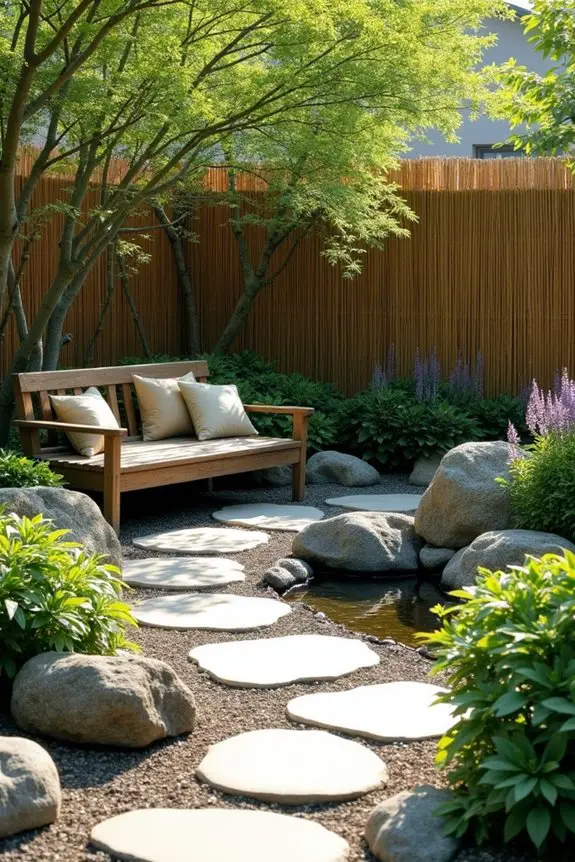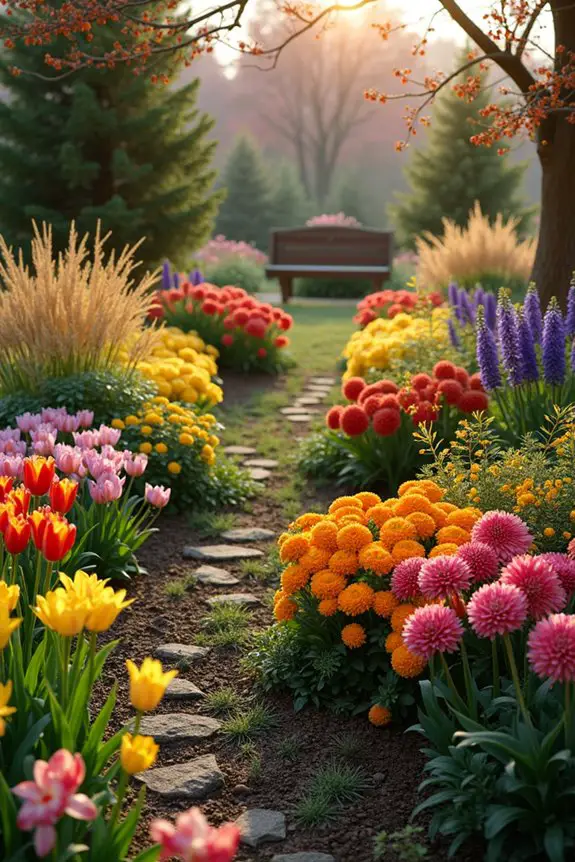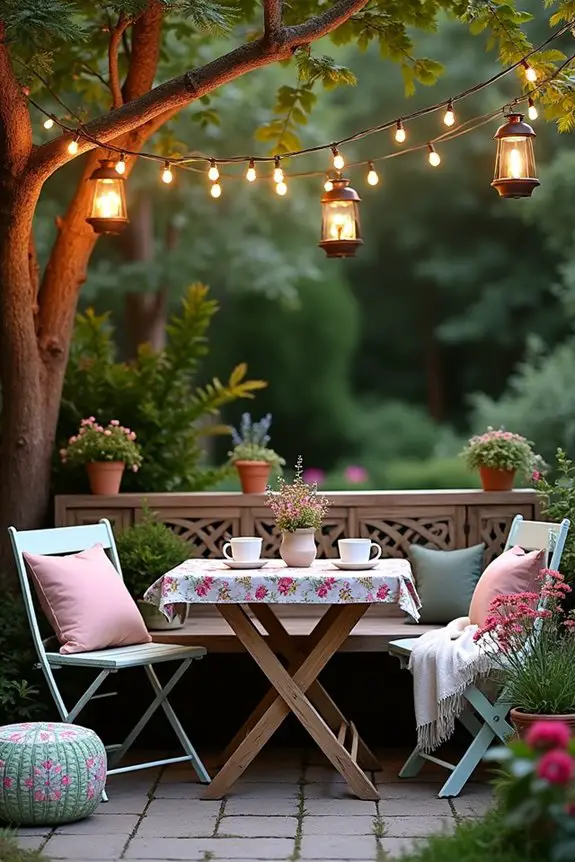Funny coincidence: I was just daydreaming about a serene Japanese garden while binge-watching a cooking show. Doesn’t that sound like a perfect escape? If you’re looking to turn your backyard into a slice of tranquility, you’re in the right spot. From winding paths to soothing water features, there are so many ideas to explore that can transform your outdoor space into a peaceful retreat. Ready to get inspired and create your own zen paradise?
The Tranquil Zen Aesthetic
When you think about creating a Zen garden, you’re probably dreaming of peace and balance, right?
Imagine this: perfectly placed stone lanterns, a gentle water feature, and a bamboo fence that whispers tranquility.
It’s all about the harmony of plants and pathways, guiding you to your own little haven where stress just melts away.
1. Stone Lantern Integration
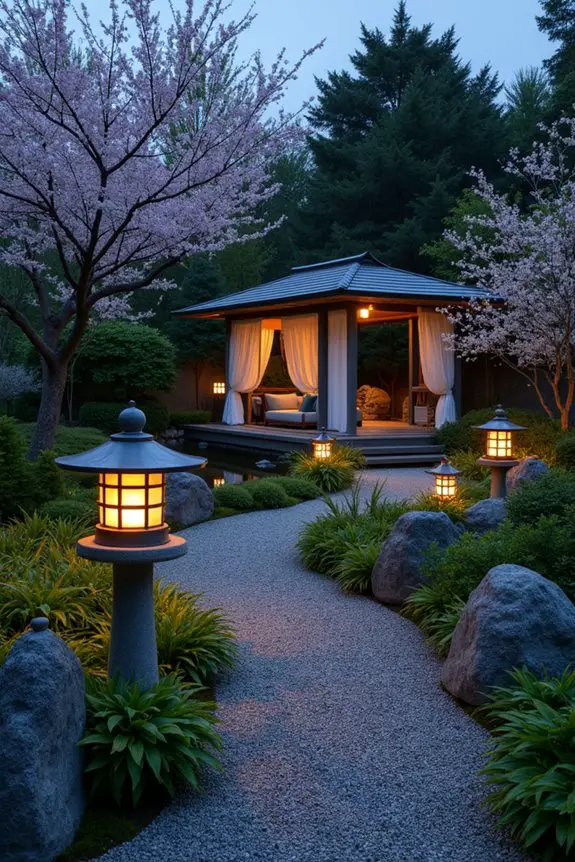
When it comes to creating that serene and peaceful vibe in your Japanese garden, integrating stone lanterns is like adding the perfect sprinkle of seasoning to your favorite dish.
These charming features not only offer gentle illumination at night, but they also embody the essence of Zen aesthetics, bringing balance and tranquility to your outdoor space. An aluminum garden gazebo can also provide a perfect spot to enjoy the ambiance created by these serene lanterns.
Who wouldn’t want a little serenity in their life, right?
Picture this: you’ve just had a long day, and all you want is a little escape. A stone lantern nestled amongst your lush greenery can provide that cozy spot for reflection or a mini escape into your own Zen retreat.
Plus, they add structure and a focal point – like that one best friend who always draws the attention at parties. Imagine the soft glow of light catching the edges of delicate petals and moss-covered stones as the evening sets in. It’s simply magical.
So, how do you go about incorporating these beautiful lanterns into your garden? Start by choosing a style that resonates with you.
Do you prefer the classic look of a Yukimi lantern, which looks like it’s swooped straight out of a fairytale? Or perhaps a Tōrō lantern, which has more of that rustic feel? Whatever you select, it’s essential to keep the lanterns in harmony with the surrounding plants and landscape.
Placement is key. You want to create a flowing path that guides the eye, almost like a gentle whisper through the garden.
Think about placing your lanterns along walking paths, near water features, or around seating areas—places where you might want to enjoy those quiet moments. Additionally, consider pairing them with a decorative bird bath, as they can enhance the overall aesthetic and attract local wildlife.
But be careful! Don’t go overboard and treat them like garden gnomes. Too many can make it feel crowded and chaotic. Yikes, nobody wants a garden that feels like a crowded subway train.
And remember, accent lighting should complement rather than overpower. A simple trick is to spotlight certain plants or sculptures with your lanterns.
It’s like highlighting your favorite passages in a good book, drawing attention to what makes your garden unique.
2. Water Element Arrangement
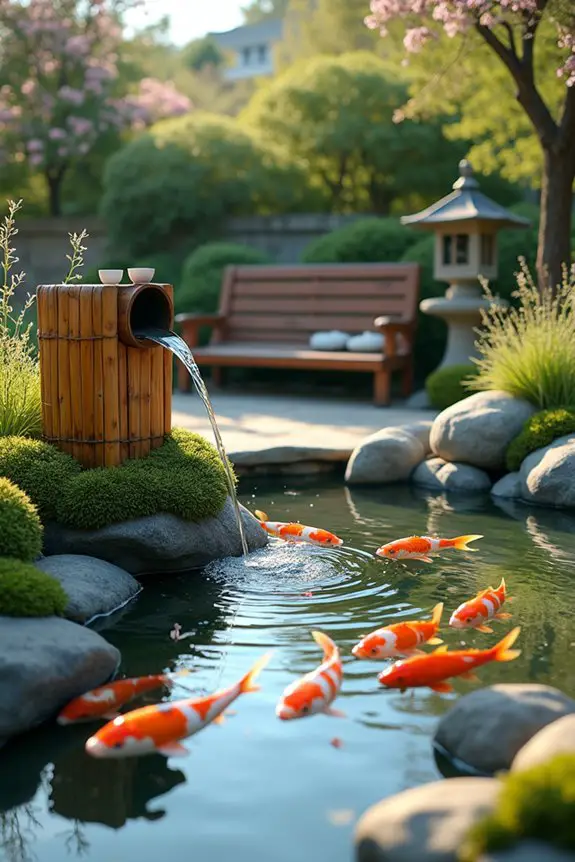
When it comes to achieving that serene vibe characteristic of Japanese gardens, incorporating a water element is key. Think of it as adding a delicate spice to your favorite dish—just the right amount can transform everything. Water features not only provide that calming sound of trickling water, making everyday stresses feel miles away, but they also bring a sense of fluidity and life to your outdoor space. Garden water features can come in various styles, allowing you to choose the perfect fit for your aesthetics.
Imagine walking into your garden and immediately hearing the gentle splash of a small pond or a serene waterfall. It’s like nature’s soundtrack, inviting you to slow down and breathe. Water draws the eye and can serve as a reflective surface, mirroring the beauty around it. Creating a space where you can sip tea while listening to the gurgle of a stream is beyond blissful, isn’t it?
So, how do you go about incorporating water in a way that enhances your space? Start by considering the size and style of your garden. A tiny courtyard might benefit from a modest, bubbling fountain, while a larger area could accommodate a koi pond, complete with those colorful fish that seem to have their own personality.
The trick is to keep it harmonious—just like pairing food and wine, you want to complement what you already have going on.
Next, think about placement. Water features should be strategically placed to draw attention, but not so much that they overshadow everything else. It’s all about balance here. For instance, a decorative fountain nestled among flowering plants can create a delightful focal point.
And hey, if you have a little bench nearby, you’ve got yourself the perfect reading nook. Just don’t forget to keep your feet dry—you wouldn’t want a soggy book ruining your Zen moment.
Don’t shy away from making this element unique! Whether it’s adding stones around the pond to create a natural habitat or a bamboo spout gently pouring into the water, little touches can create an inviting and tranquil atmosphere. Additionally, consider enhancing your setup with a solar garden water pump to make maintaining the water feature effortless and sustainable.
Remember, the goal is to create a little oasis where you can escape the hustle and bustle of life, one soothing ripple at a time. Updating your garden with a water feature might just be the best decision you make. It’s like turning up the flavor in your favorite dish; suddenly, everything feels fresher and more inviting.
And who knows? You may find yourself spending more time outside than you ever thought possible, soaking in that peaceful ambiance, like a Zen master in their natural habitat.
3. Bamboo Fence Incorporation
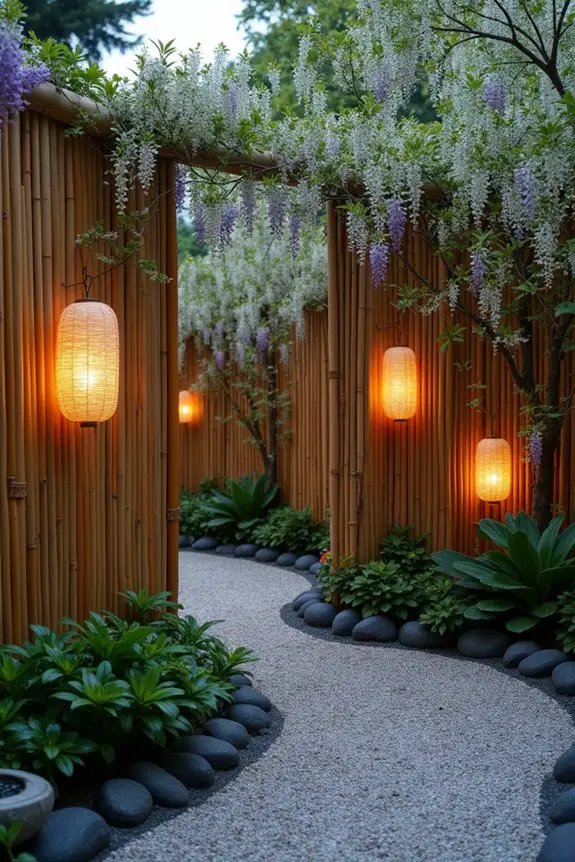
Bamboo fences transport your backyard into a serene Zen paradise. They’re like nature’s stylish privacy screen, blending functionality with an effortless aesthetic that says “calm” from every angle. Envision enjoying your morning coffee while feeling wrapped in a cocoon of tranquility, all thanks to that simple yet chic barrier.
When considering bamboo fence incorporation, you first want to think about where you’ll place it. Is there an area you’d like to shield from peering eyes, or perhaps a section that needs a little pizzazz? Bamboo works wonders in both scenarios. It’s lightweight, easy to install, and surprisingly strong—kind of like that one friend who always seems to figure things out.
You might opt for a full enclosure, giving yourself that private Zen retreat, or use shorter panels to create a more open vibe. If you’re feeling adventurous, mix in some other materials, like wooden posts or mesh wire, for a touch of variety. Visualize a graceful line of bamboo framing a small garden path, inviting you in as your worries melt away. The soft rustle of bamboo in the breeze? Pure bliss.
One fun way to enhance the bamboo fence is to add climbing plants like jasmine or wisteria. They’ll tumble and twine around the bamboo, creating a living wall that smells heavenly—talk about an aromatic upgrade. Just remember, as much as it sounds appealing, don’t let the vines take over like that house plant you forgot in your closet. A little trim here and there goes a long way.
Finally, accessorizing can truly elevate the look. Think lanterns hung from the bamboo to create a soft glow at dusk, or even some cute little decorative stones placed at the base for that extra personality. You want the fence to feel integrated into your garden, as if it’s always been a natural part of the space.
4. Pathway Layout Planning
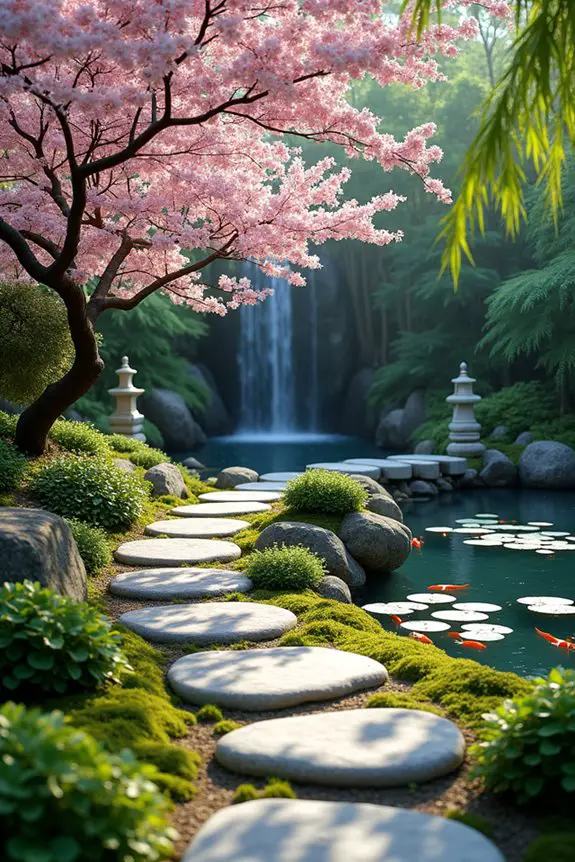
Creating a beautifully designed pathway in your Japanese garden isn’t just about having a way to stroll through your space; it’s about crafting an experience that’s both calming and inviting. A thoughtfully laid path offers direction, guides the eye, and adds structure to the chaos of nature. Sounds dreamy, right?
When planning your pathway layout, start with the concept of flow. Picture how your guests—yes, even that neighbor who always shows up unannounced—will navigate through the garden. Aim for curves and gentle turns; they beckon visitors forward. Straight paths can feel a bit rigid or, dare I say, boring. A winding path feels natural, like the garden itself is gently coaxing you to explore its secrets.
Consider materials, too. Smooth pebbles, stepping stones, or even natural wood can enhance that Zen vibe. Imagine the satisfying crunch of gravel underfoot as you stroll; it’s like nature’s way of saying, “You’re on the right track.” Just avoid anything slippery, unless you’re trying to prove a point to that neighbor about the beauty of gardening mishaps.
Now, don’t forget about the width. A path that feels too narrow can be a hassle, especially when you and that unexpected guest are trying to squeeze past each other. Aim for at least two feet wide—enough space for two people walking side by side, ideally while enjoying a light-hearted chat about gardening triumphs and misadventures.
As you design your path, look at how it interacts with your garden features, like ponds or stone lanterns. The path should lead to focal points that draw the eye, making the whole space feel cohesive and polished. Think of it as the cherry on top of your Zen-like sundae.
Finally, sprinkle in some ambient lighting or subtle plantings along the edges. It’s like giving your path little hugs of greenery, inviting visitors to take their time. Just a flickering lantern here or a delicate flower there can enhance that serene atmosphere, making evening strolls feel like a soft embrace from nature.
5. Plant Selection Harmony
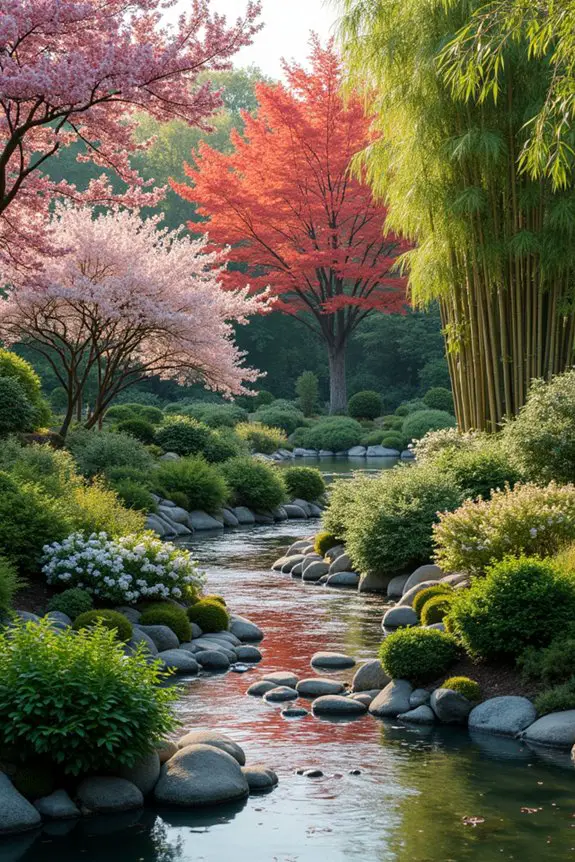
When it comes to creating a Japanese garden, the choice of plants plays a vital role in establishing that calming atmosphere we all crave. It’s not just about filling space with pretty flowers; it’s about crafting a symphony of textures, colors, and forms that work in harmony with one another.
Imagine stepping into a serene landscape where every plant has a purpose, contributing to the relaxation of both body and mind.
To kick off your plant selection journey, think about layering. This concept isn’t just for your music playlist—it applies to your garden too. Start with taller plants at the back, like graceful bamboo or elegant flowering cherries, and progressively work your way down to smaller shrubs and ground cover.
This layering creates depth and allows your garden to draw the eye in, making it feel expansive even in tight spaces. The best part? It also provides habitats for birds and insects, giving them a cozy little home and us extra garden beauty.
Color is another key ingredient in this tranquil aesthetic. Go for a palette that reflects tranquility: soft greens, subtle blues, or gentle whites. You want to achieve that calming vibe, right?
Maybe sprinkle in a few splashes of bright color with delicate blooms, but keep them balanced. A riot of hues might feel festive, but too much can be like adding spicy ginger to your sushi—it can overwhelm instead of complement.
Now, let’s chat about texture. There’s nothing quite like the soothing rustle of ornamental grasses or the rough charm of moss to create that Zen effect.
Plant some ferns alongside those smooth stones you so thoughtfully arranged on your pathway. This contrast can turn your garden into a tapestry of nature’s best work, inviting you to lose yourself in it all. Plus, it gives the neighborhood cat enough cover to plot their next garden takeover!
For that ultimate tranquil vibe, don’t forget about the seasonal aspect of plants. Imagine how lovely it’s to have your garden change with the seasons.
You could plant azaleas that burst into bloom in spring, or maybe a maple tree that turns fiery red in fall. Watching these transformations can feel like nature’s own version of reality TV—drama, beauty, and heartfelt moments, all in your backyard.
Additionally, consider incorporating an herb seed variety pack to enhance the sensory experience in your garden, as these plants can contribute delightful aromas and flavors to your tranquil space.
In the end, selecting plants for your Japanese garden is about more than just picking what looks pretty. It’s crafting a peaceful retreat that invites you to unwind, reflect, and maybe even find a bit of clarity in this chaotic world.
6. Koi Pond Feature Placement
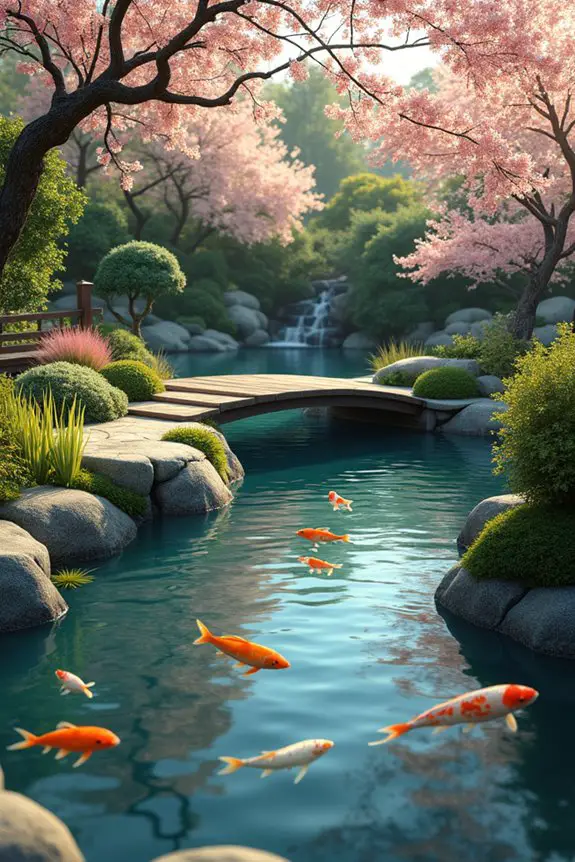
When you think of a Japanese garden, one of the most iconic features that often springs to mind is a koi pond. Not only does it add a striking focal point to your garden, but it also brings a sense of peace and tranquility. Imagine the gentle sounds of water lapping against the rocks, and, let’s be honest, who wouldn’t want their own little piece of paradise right at home?
Finding the perfect spot for your koi pond is crucial to creating the serene atmosphere you desire. Ideally, you want to place it where you can easily enjoy it, maybe right by your favourite bench or under that beautiful cherry tree you’ve been dreaming of.
But don’t forget about the sun! Koi love to sunbathe, so a location that gets a mix of sun and shade is ideal. Think about it: koi in a sunbeam can make quite the daydream moment.
When arranging the pond, consider integrating natural elements around it. Adding smooth stones, soft moss, and gently waving grasses will create those soothing textures we talked about earlier. Plus, these elements will harmonize perfectly with the playful movement of the koi. Just picturing them gliding through the water feels so peaceful, doesn’t it?
Another critical tip is to think about the visibility of your pond from various angles. It shouldn’t just be a lovely surprise when you’re standing right next to it. Maybe position a couple of stepping stones or a wooden bridge leading up to it, which encourages playful exploration.
In my own garden, I placed stepping stones that make you feel like you’re on a little adventure every time you go check on the koi. I mean, who doesn’t want a mini trek to their tranquil corner of the world?
And if you’re feeling adventurous, consider adding a small waterfall feature. Not only do they elevate the aesthetic, but they also create soothing sounds that drown out the hustle and bustle of daily life. It’s like having your personal symphony of nature, ready to serenade you.
I thought about putting one in, but with my luck, I’d likely turn it into a backyard splash zone instead.
In the grand scheme, placing a koi pond in your Japanese garden can create that dreamy, tranquil vibe. It draws people in, encourages reflection, and, let’s be honest, provides an ideal spot for which to sip tea and enjoy moments of stillness.
7. Seasonal Color Scheme Planning
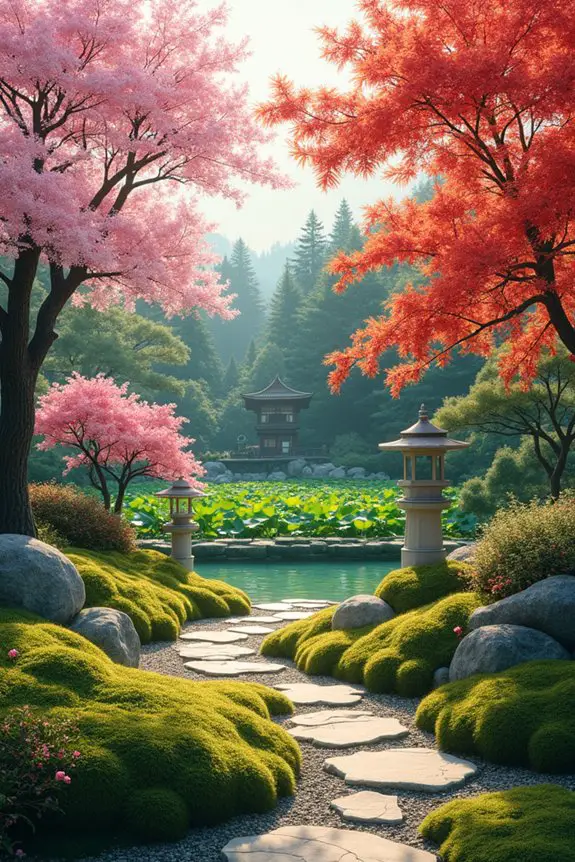
When planning the seasonal color scheme for your Japanese garden, you’re crafting not just a visual delight but also a calming experience. The right colors can evoke feelings of serenity and harmony, mirroring the tranquil vibes we associate with Zen aesthetics. Envision your garden as a canvas, where every bloom, every leaf, tells a story throughout the seasons.
Start by picking a palette that resonates with you. In spring, soft pink cherry blossoms and vibrant green foliage can create a gentle sense of renewal. Don’t you just love that awakening feeling? It’s like spring does a little dance, coaxing everything back to life.
During summer, you might lean into lush shades of deep greens mixed with pops of bright lotus flowers or mischievous reds from the maples, adding that playful energy. In autumn, the warm hues of oranges and yellows can transform your garden into a cozy retreat, reminiscent of sipping hot tea on a crisp day.
Consider layering your colors. Having different heights and textures is essential, too—think about taller plants in back, and smaller, more delicate blooms in front. It creates depth, and oh boy, does that bring everything together beautifully.
For instance, a backdrop of Japanese black pines can harmonize perfectly with the breezy waves of white cloud grasses. When I tried this in my own yard, it felt like Mother Nature herself was nodding in approval.
Don’t forget about winter. You can add evergreen elements and berries for bursts of color during the colder months. Imagine this: a frost-kissed holly with a backdrop of snow. Stunning, right? I mean, I mightn’t love the cold, but even I’ve to admit it’s like nature’s way of showing off a little.
As you select your flowers, consider their bloom times. Aim for a staggered schedule that offers something beautiful in every season. It’s like creating an ongoing garden party, where you’re always invited to admire the latest guest. Honestly, it feels great strolling through your own little paradise, knowing there’s always something surprising waiting to greet you.
In the end, a seasonal color scheme in your Japanese garden isn’t just about aesthetics. It’s about creating a living masterpiece that soothes the soul, a reflection of the beauty that each season has to offer. So grab your sketchbook, let your imagination run wild, and start planning your serene slice of Japan right at home.
8. Fragrant Herb Garden Placement
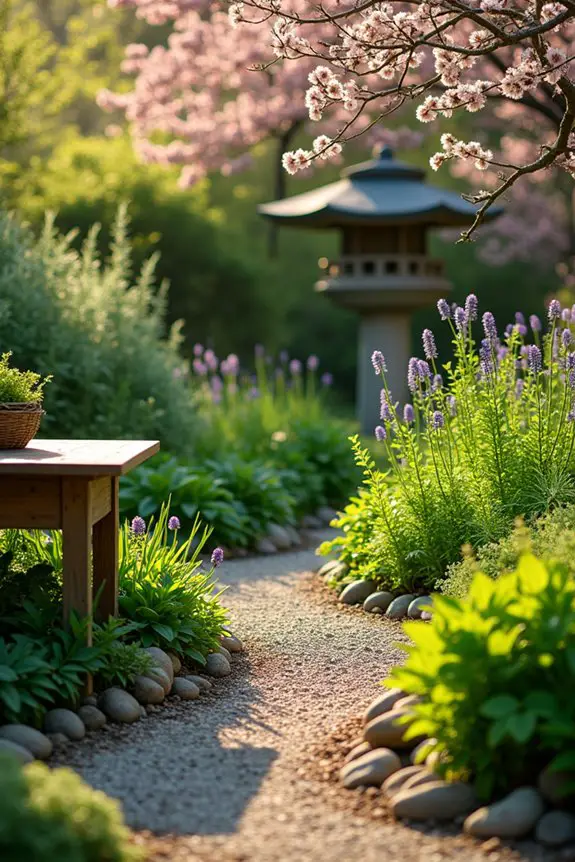
When it comes to creating a fragrant herb garden in your Japanese garden, placing your herbs just right can really elevate both the smell and the tranquility of the space. Imagine this: as the sun shines down, you stroll past aromatic basil, mint, and thyme, each step releasing a delightful whiff that dances through the air. It not only adds functionality but sets a serene, calming vibe that makes you feel completely at peace.
First things first, think about location. Herbs love sunlight, so place them where they can soak up those golden rays. A sunny spot near the entrance of your garden is perfect—imagine walking into your peaceful haven, greeted by a burst of fragrances. You really can create an atmosphere that draws you in. (Trust me, I’ve spent way too many afternoons sniffing my herbs while pondering life’s great mysteries… like why I can never seem to find my car keys.)
Next, don’t forget about accessibility. If you’re cooking with these herbs, having them near your kitchen or a little outdoor table can make them super handy. You’ll want to pick fresh basil for that pasta or pluck mint for a rejuvenating tea without having to trek all the way across the garden. It’s like having miniature flavor soldiers ready at your service. And as you gather your herbs, just picture the smile it’ll bring to your face to add that touch of vibrancy to your meals.
Now, let’s talk arrangement. Mixing taller herbs like dill or fennel with shorter ones like chives and thyme creates a layered garden that’s not only visually appealing but also functional. As you roam through, it’s like a fragrant dance party, with tall herbs in the back and low-growing beauties up front, all strutting their stuff. I tried this in my own garden, and, honestly, it was like I was hosting a rock concert where each herb had its solo moment.
And don’t forget to think about textures, too. Combining the soft, feathery nature of herbs like parsley with the bold leaves of oregano creates a gorgeous tapestry. It adds depth and invites exploration—after all, who doesn’t want to wander a little deeper into a fragrant wonderland?
Finally, embrace the seasons—just like your flowers, your herbs might have different peak moments. Plant a mix that allows for year-round enjoyment. I once had thyme that took on a whole new flavor profile in the winter sun. Well, that’s if you can keep track of time while gardening; I swear I blinked and forgot I was out there, losing hours to the scents wafting around.
In a nutshell, placing fragrant herbs in your Japanese garden is about more than just growing plants. It’s about creating an inviting slice of calm—where every sniff brings a sense of peace and every dish benefits from the bountiful offerings at your fingertips. So, ready to start planting? Your garden’s next fragrant chapter awaits!
9. Stone Placement Techniques
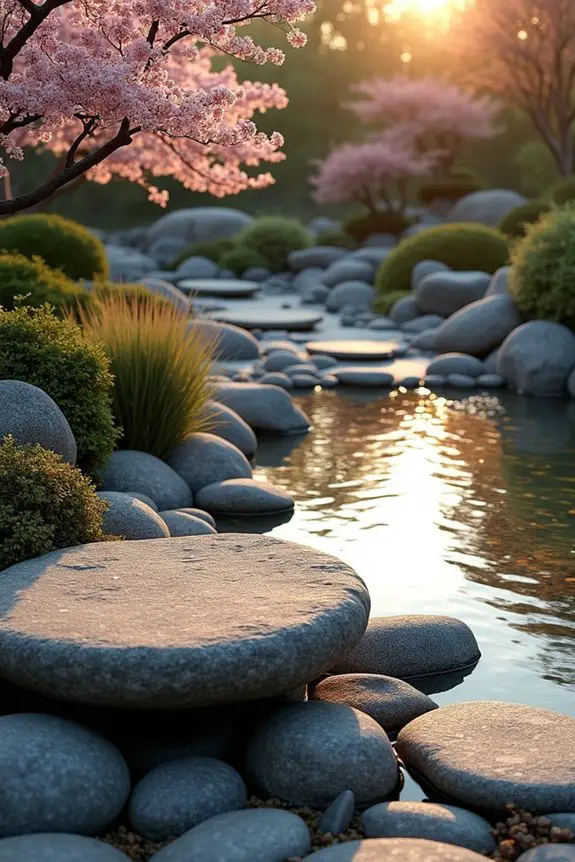
So, let’s talk about where to place these stones. Start by considering the focal points in your garden. Position larger stones as anchors, maybe around a water feature or at the base of a small tree, to draw the eye and create natural pathways.
When I was figuring this out in my own garden, I realized that placing a big, flat stone near my koi pond not only looked nice but also gave my guests a perfect spot to sit and take in the view—once they figured out how to navigate through my patch of wild mint, of course.
Then there’s the art of balance. Mixing sizes and shapes can add movement to your stone arrangement. Pair smooth, round stones with sharp, jagged ones for an engaging contrast.
I went a little wild once and dumped a mix of river stones and granite pieces in a pile. Let’s just say, my garden looked more like a rock concert than a tranquil retreat. You want to create harmony, not chaos, so find that sweet spot where the stones talk to each other, both visually and through their texture.
Don’t overlook that all-important spacing, either. Placing stones too close together can feel cramped, while too much space can break the flow. Think of it as introducing your friends—some need room to breathe, while others are happy to hug it out.
I’ve been known to spend way too long rearranging stones until it felt like they were having a pleasant conversation instead of a quarrel.
Finally, think about how these stones can lead you through the garden. Incorporating smooth stones or stepping stones can create a natural path, guiding visitors to points of interest.
When I finally introduced those stepping stones, my friends joked that they finally had directions that even I couldn’t screw up. It’s like creating a gentle nudge for those wandering through, inviting them to discover each nook and cranny of your space.
With well-placed stones, your garden transforms into a calming escape that invites peace and reflection. You’ll be amazed at how such a simple element can make all the difference. Now, who’s ready to go rock hunting?
10. Natural Material Sustainability
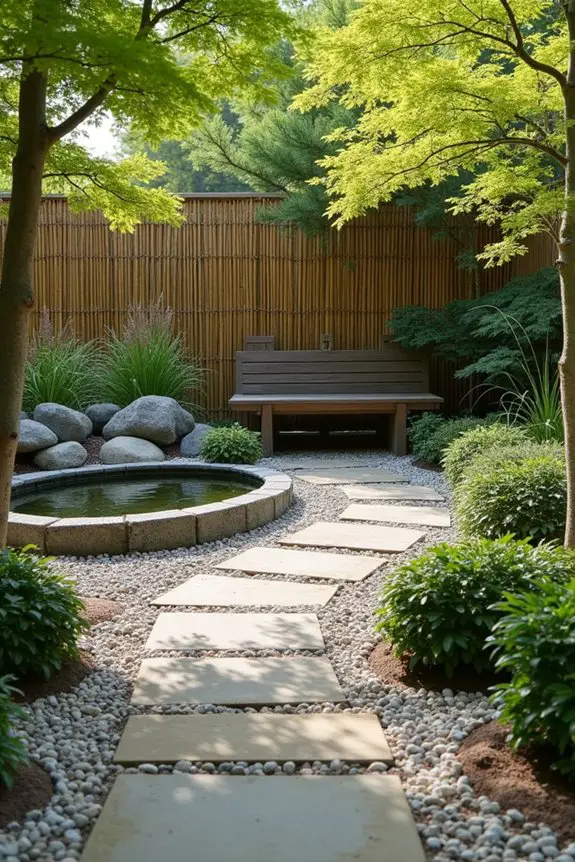
When it comes to creating that serene, Zen-like atmosphere in your Japanese garden, focusing on natural materials is key. Using local stones, wood, and plants not only helps the environment but also enhances the authenticity of your garden. Imagine this: a gently bending bamboo fence, smooth river stones, and a calming water feature. It’s like nature itself designed your space, inviting tranquility with every step.
Start by sourcing materials that are indigenous to your area. Not only does this cut down on the carbon footprint of transporting items, but it also makes your garden feel naturally grounded. I learned this while working on my own garden; finding local flagstone for my pathway added a rustic charm that transported me straight to a serene hillside every time I glanced out the window.
Next, think about incorporating reclaimed wood. It’s a fantastic way to introduce character and history into your design. I once salvaged old barn wood and turned it into a rustic bench. Sure, it took a few trips to my local lumber yard, and I may have managed to accidentally nail my thumb once or twice.
But once it was finished, it became the favorite spot for sipping tea while enjoying the garden view—who knew splinters could have such a backstory?
Plants also deserve attention when working towards that peaceful vibe. Opt for native plant species that thrive without much fuss. Remember my obsession with that rare fern? The one that needed constant attention and only bloomed during a full moon?
Total nightmare. Instead, I’ve now swapped it with a lovely hosta that blooms beautifully and happily sits in the shade. It’s super low-maintenance and keeps my garden looking lush without me breaking a sweat.
Lastly, don’t forget about color harmony. Selecting materials that blend seamlessly can amplify that tranquil aesthetic. Think soft browns, muted greens, and gentle grays—aim for a color palette that evokes calm.
I tried to have a bold red bench once, convinced it would pop, but what I got was more “agitated zoo” than “peaceful retreat.” Now, stick to shades that evoke those gentle, earthy tones and watch how your space transforms.
Soil Quality Improvement Methods
There’s something magical about digging your hands into the soil, but let’s face it—if the earth beneath your feet is more like a rock than a sponge, your garden dreams might feel out of reach.
For those small Japanese garden ideas you’ve been dreaming about, improving soil quality is key. Start by mixing in some organic compost; it’s like giving your soil a good meal.
Try adding worm castings, too—yes, they’re just as special as they sound. Don’t forget to till in some peat moss for moisture retention. Honestly, think of it as your garden’s luxury spa day.
And hey, water frequently, but don’t drown the poor soil. Trust me; it’s like walking a fine line between love and a soggy disaster.

